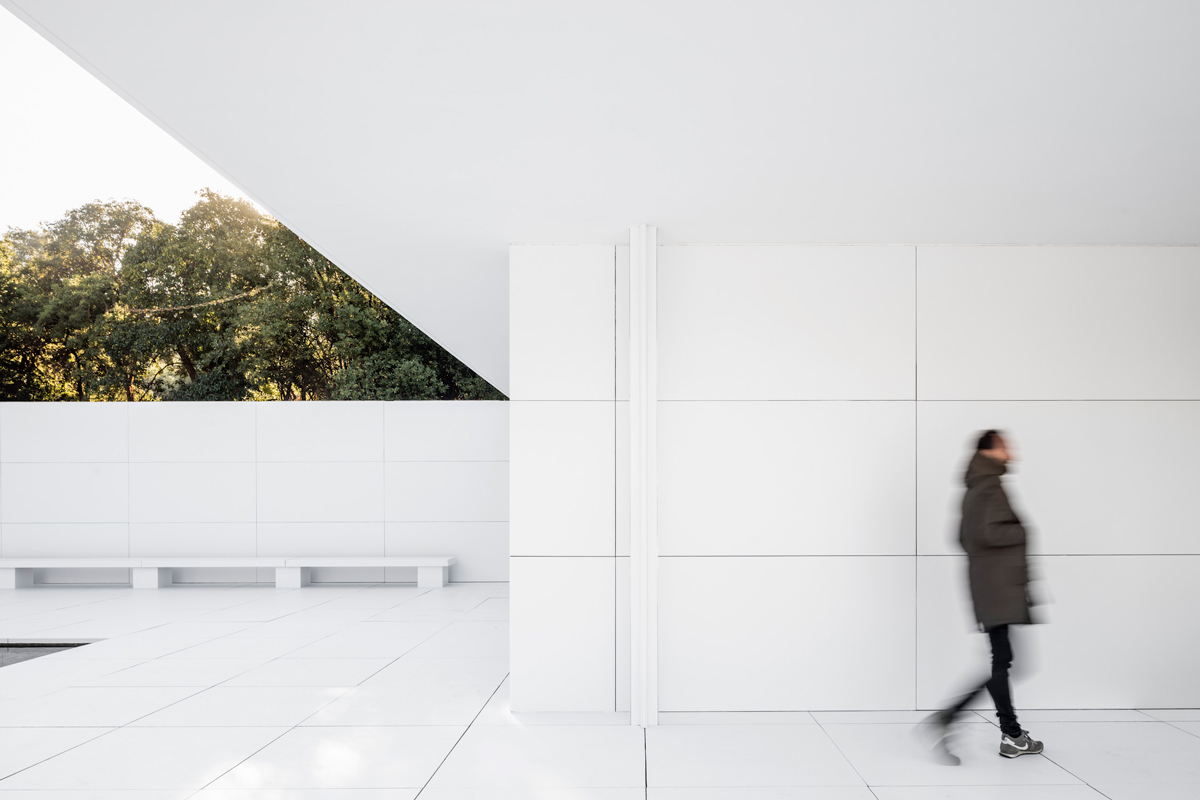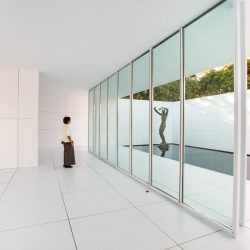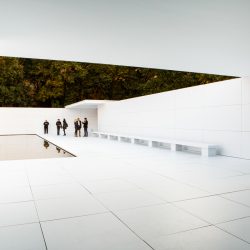THE RECENT INTERVENTION PROJECT AT THE BARCELONA PAVILION APPLIED A STRONG WHITE-WASHING OVER ALL MATERIALS
The image of white vinyl being gradually installed, visually and physically corresponding with the proportion of the materials whose presences contribute to the materialization of Barcelona Pavilion’s interior element, be it the travertine marble of the benches by the outside pool, the Tinos and Vert antique marble used of the floors and walls or the Golden Onyx slabs that take the leading role in the structure’s interior space, all collectively light up the entire architecture into a mesmerizing whiteness, culminating in the latest work by Spain’s up-and-coming architects Anna & Eugeni Bach invited by The Fundació Mies van der Rohe to be in charge of the pavilion’s artistic transformation.
Named ‘mies missing materiality,’ the whitened pavilion is Anna & Eugeni Bach’s attempt to restrict the variations of the materials of the interior space into one harmonized surface using the color ‘white.’ Such homogeneity causes viewers to lose the hierarchy of perception towards the space, which is conventionally determined by the variations of materials. The architects also borrow the symbolic meaning of ‘white’ as a color, and its relation to the history of modern architecture and how it is regarded as one of the key elements of the Modern ideology. Such use creates a debate over the building’s strong historiographical image and how the use of white, which is the popularly used color of modern architecture, affects the meaning of the work in general.
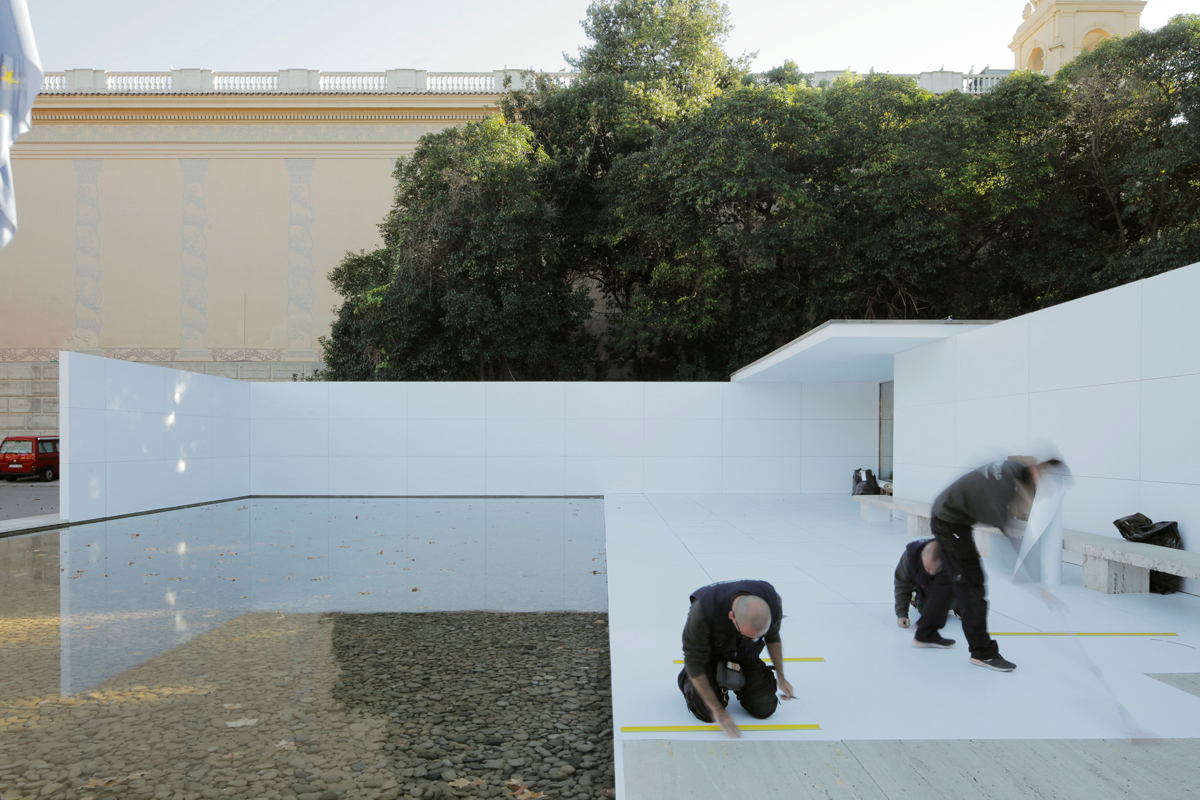
AN IMAGE TAKEN DURING THE COVERING PROCESS WHERE ALL PRIOR DETAILS WERE WRAPPED UP AND OBSCURED
In 1955, Mies van der Rohe told John Peter in an interview, which was later published in the book titled The Oral History of Modern Architecture (1994), that the starting point that determined the proportion of the Barcelona Pavilion was the limited height of the Onyx slabs. By using two slabs for the construction of an interior wall, the height of the wall indicates the height of the building and, as a result, the proportions of the space and other types of materials being included in the design. With Anna & Eugeni Bach’s transformation, the surfaces are entirely replaced with white vinyl. Intentionally left behind are traces that reveal the remaining scales and proportions of the original materials even though they are now no longer a part of the context that was once the conditions of their presence.
While Anna & Eugeni Bach plays with the Barcelona Pavilion in the aspect of historical representation, the pavilion itself is a replica that has been immortalized. The Fundació Mies van der Rohe’s attempt to reconstruct the structure to commemorate Mies van der Rohe’s 100 years in 1986 has caused the Barcelona Pavilion to reemerge after its absence from the face of the earth before turning it into a legend within Modern Architecture’s narrative for the past 56 years. The architectural legend is told through photographs, the floor plan and drawings of the interior landscape, which throughout the period of almost six decades, only a few have survived. It appears in the shapes and forms of magazine articles, essays in books and exhibitions before the structure was demolished following the last showcase in 1930. If one were to contemplate the structure from a historical point of view, Anna & Eugeni Bach’s work isn’t the pavilion’s first ‘missing materiality.’

THE OVERALL ATMOSPHERE OF THE PAVILION AS IT WAS COMPLETELY COVERED IN WHITE
Alison and Peter Smithson wrote in their book, Changing the Art of Inhabitation (1994) that they had a hard time coping with the reconstruction of the Barcelona Pavilion when they first visited it in 1985 for the colors of marble and other materials were nothing like the ideal image of the architecture they had in mind when they were first introduced to the work as college students. They got to know the legendary pavilion from black and white photographs published in different publications as an ideal creation of modern architecture. To them, the reemergence of the pavilion is out of time, out of place and destroys the ideal image of the Barcelona Pavilion that was once untouchable in their time.
Anna & Eugeni Bach’s ‘mies missing materiality’ is a palimpsest of the thirty-year-old Barcelona Pavilion replica whose existence has spanned long enough to replace the image of the pavilion back in the time of Alison and Peter Smithson. It is safe to say that over 90% of the images of the Barcelona Pavilion in the media are photographs of the 1986 replica. With the majority of people not realizing such fact, the debate about the destruction of the architecture’s original value naturally follows. Some say that the work’s superficiality devalues the integrity of the original Barcelona Pavilion while some view the use of the white color to replace the materials’ surfaces as an uninteresting and somewhat weak historical reminiscence of the work. But if we were to look at Bach’s intention to bring the audience to experience the space where the hierarchy of perception towards the space is made nonexistent through the use of material, at the very least, we might be able to discuss the importance of materials and the effects they have on humans’ perceptions of space with ‘mies missing materiality’ being one of the case studies.
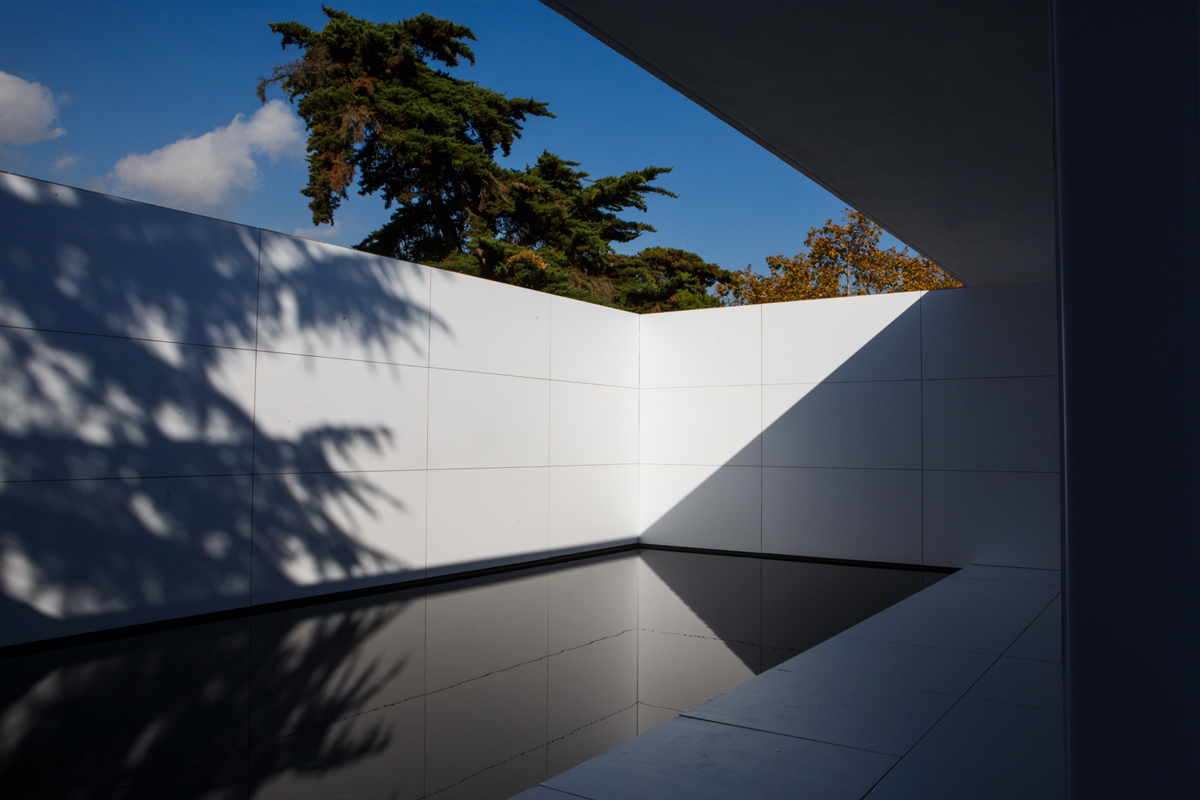
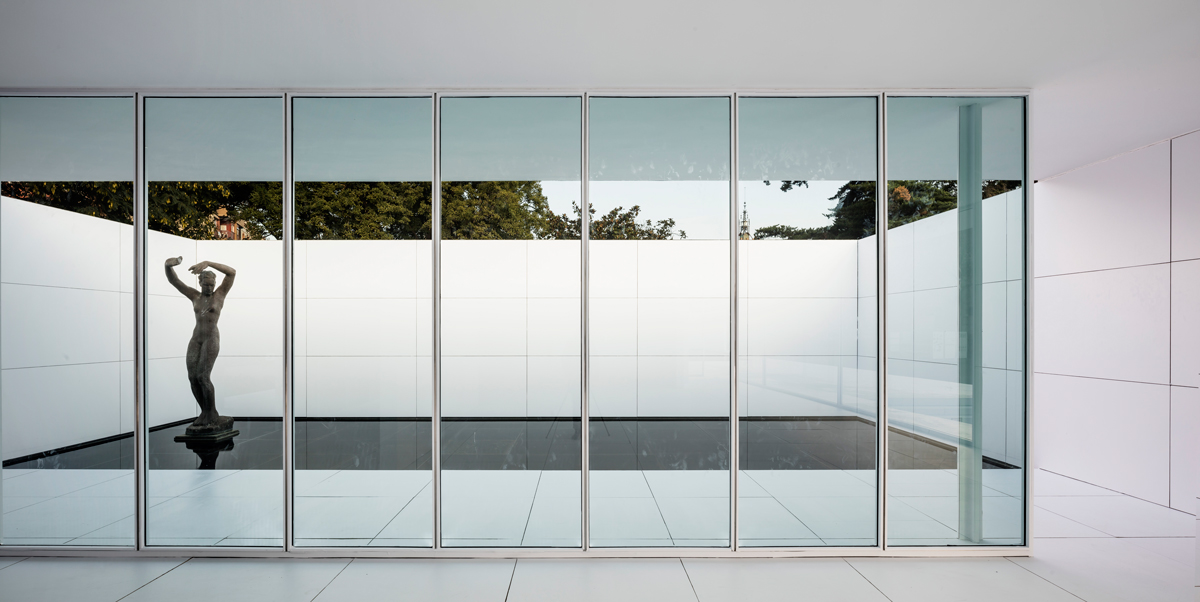
ภาพของแผ่นไวนิลสีขาวค่อยๆ บรรจงติดทับลงไปตามขนาดสัดส่วนของวัสดุที่อยู่ภายใน Barcelona Pavilion ไม่ว่าจะเป็นหินอ่อนทราเวอทีน (travertine) ที่บริเวณม้านั่งริมสระน้ำภายนอกอาคาร พื้น และผนังหินอ่อนภายในอาคาร ทั้งหินอ่อน Tinos และ Vert antique รวมถึงแผ่นแร่โอนิกซ์สีทอง (Golden Onyx) ที่เป็นวัสดุผนังชิ้นสำคัญของพื้นที่ภายใน Barcelona Pavilion จนในที่สุดตัวอาคารจึงขาวโพลนไปทั้งหลังนั้นเป็นผลงานล่าสุดในโครงการ Pavilion Interventions ของสถาปนิกรุ่นใหม่ชาวสเปน Anna & Eugeni Bach ที่ The Fundació Mies van der Rohe ได้เชิญมาร่วมโครงการในปีนี้
Anna & Eugeni Bach ตั้งชื่อปรากฏการณ์ของความขาวโพลนไปทั้ง pavilion ของพวกเขาชิ้นนี้ว่า ‘mies missing materiality’ พวกเขาต้องการหลอมรวมพื้นผิวที่ประกอบไปด้วยวัสดุหลากหลายที่อยู่ภายใน pavilion ทั้งหมดให้กลายเป็นเนื้อเดียวกันด้วยการเปลี่ยนทั้งหมดให้กลายเป็น “สีขาว” เพื่อให้ผู้เข้ามาเยี่ยมชมสูญเสียการรับรู้ในเรื่องลำดับชั้น (hierarchy) ของพื้นที่ว่างภายในที่เคยถูกกำหนดขึ้นจากวัสดุชนิดต่างๆ นอกจากนั้นพวกเขายังหยิบยืมสัญญะของ ‘สีขาว’ ที่มีความสัมพันธ์กับประวัติศาสตร์ทางสถาปัตยกรรมสมัยใหม่ในฐานะที่มันเป็นอุดมการณ์ในเรื่องการเลือกใช้สีที่สำคัญ เพื่อนำมาตั้งคำถามที่สร้างความขัดแย้งในงานชิ้นนี้ว่าจะเป็นอย่างไร ถ้าอาคารที่มีภาพลักษณ์ทางประวัติศาสตร์ (historiographical image) ที่แข็งแรง ถูกแทนที่ด้วยสีขาวซึ่งเราสามารถพบเห็นได้โดยทั่วไปในงานสถาปัตยกรรมสมัยใหม่
ในปี ค.ศ. 1955 Mies van der Rohe เคยให้สัมภาษณ์ John Peter โดยบทสัมภาษณ์ชิ้นนั้นได้ถูกบันทึกไว้ในหนังสือ The Oral History of Modern Architecture (1994) ว่าจุดตั้งต้นที่เป็นตัวกำหนดสัดส่วนของ Barcelona Pavilion เกิดจากข้อจำกัดของขนาดความสูงของแผ่นแร่โอนิกซ์ (Onyx) ที่ใช้เป็นวัสดุในการก่อสร้าง โดยเขาใช้วัสดุสองแผ่นมาต่อกันเป็นผนังภายใน ซึ่งความสูงของผนังชิ้นนี้นี่เองที่เป็นตัวกำหนดความสูงทั้งหมดของอาคาร สัดส่วนของพื้นที่ และขนาดวัสดุชนิดอื่นๆ ทั้งหมดที่นำมาใช้งานด้วย ซึ่งในงานของ Anna & Eugeni Bach ขณะที่ผิวของวัสดุต่างๆ ของ pavilion ถูกแทนที่ด้วยแผ่นไวนิลสีขาวทั้งหมด แต่ร่องรอยที่บริเวณรอยต่อของวัสดุตามจุดต่างๆ ที่แสดงให้เห็นถึงขนาดและสัดส่วนของวัสดุชนิดนั้นๆ ยังคงอยู่ แต่อยู่แบบตัดขาดจากบริบทที่เป็นเงื่อนไขดั้งเดิมของมัน
ถึงแม้ว่า Anna & Eugeni Bach จะพยายามเล่นกับภาพแทนความเป็นประวัติศาสตร์ของ Barcelona Pavilion แต่ในขณะเดียวกันตัว pavilion แห่งนี้ก็เป็นของจำลอง (replica) ที่ถูกทำให้ดำรงอยู่อย่างถาวร ซึ่งทาง The Fundació Mies van der Rohe ได้สร้างมันขึ้นมาใหม่ในวาระครบรอบ 100 ปีชาตกาลของ Mies van der Rohe ในปี ค.ศ. 1986 ทำให้ Barcelona Pavilion ปรากฏขึ้นมาอีกครั้งหลังจากที่มันหายไปจากพื้นโลก และทำให้ตัวมันเองเป็นแค่เพียงตำนานเรื่องเล่าของสถาปัตยกรรมสมัยใหม่เป็นเวลากว่า 56 ปี โดยเรื่องเล่าเหล่านั้นทำงานผ่านภาพถ่าย แบบผังอาคาร และแบบร่างของทัศนียภาพภายใน ที่หลงเหลืออยู่จำานวนน้อยนิด เป็นระยะเวลายาวนาน ผ่านบทความในหน้านิตยสาร หนังสือ และนิทรรศการต่างๆ หลังจากที่มันถูกรื้อทิ้งภายหลังจากสิ้นสุดการแสดงในปี ค.ศ. 1930 หากจากพิจารณาตามแง่มุมทางประวัติศาสตร์แล้ว ผลงานของ Anna & Eugeni Bach จึงไม่ใช่การ ‘missing materiality’ ที่เกิดขึ้นเป็นครั้งแรกของ Pavilion แห่งนี้
Alison และ Peter Smithson เคยเขียนไว้ในหนังสือ Changing the Art of Inhabitation (1994) ว่าพวกเขาทำใจไม่ได้ตอนที่ไปเยือน Barcelona Pavilion ในปี ค.ศ. 1985 ในขณะที่กำลังอยู่ในระหว่างการก่อสร้างขึ้นมาใหม่ สีสันของตัวอาคารที่เกิดจากหินอ่อนและวัสดุที่นำามาใช้ในงานสร้างขัดแย้งกับภาพในอุดมคติที่อยู่ในความคิดของพวกเขา เป็นเวลานานนับตั้งแต่ตอนที่รู้จักอาคารหลังนี้เป็นครั้งแรกสมัยที่เรียนอยู่ในมหาวิทยาลัย ผ่านภาพถ่ายขาวดำในสื่อต่างๆ ในฐานะที่มันเป็นอุดมคติของสถาปัตยกรรมสมัยใหม่ พวกเขาคิดว่าการปรากฏตัวขึ้นมาใหม่ของ pavilion เป็นอะไรที่อยู่ผิดที่ผิดเวลา และทำาลายภาพความเป็นอุดมคติของ Barcelona Pavilion ที่ไม่สามารถจับต้องได้ในยุคสมัยของพวกเขา
กรณีของ Anna & Eugeni Bach ในงาน ‘mies missing materiality’ ชิ้นนี้ก็เหมือนเป็นการเขียนทับลงไปใหม่ (palimpsest) ใน Barcelona Pavilion จำาลอง (replica) ที่มีอายุกว่า 30 ปีซึ่งการมีอยู่ของมันก็อาจนานพอที่จะทำให้มันเข้าไปแทนที่ภาพของ pavilion จริงในความทรงจำดั้งเดิมในยุคสมัยของ Alison และ Peter Smithson ในปัจจุบันนี้อาจกล่าวได้ว่ากว่า 90% ของภาพ Barcelona Pavilion ที่ปรากฏอยู่ในสื่อต่างๆ ล้วนเป็นภาพถ่ายของ pavilion จำลองที่ถูกสร้างขึ้นมาใหม่ในปี ค.ศ. 1986 แทบทั้งสิ้น ซึ่งคนทั่วไปอาจจะลืมที่จะตระหนักถึงความจริงในข้อนี้ ทำาให้เกิดข้อถกเถียงในเรื่องการทำาลายคุณค่าดั้งเดิมของผลงานสถาปัตยกรรมตามมา บ้างก็ว่านี่เป็นการทำาลายคุณค่าของผลงานจริงของ Barcelona Pavilion แบบผิวเผิน บ้างก็บอกว่าการใช้สีขาวเข้าไปแทนวัสดุต่างๆ ใน pavilion เป็นประเด็นทางประวัติศาสตร์ที่ดูอ่อนและไม่น่าสนใจ แต่ถ้าเราลองพิจารณาในประเด็นที่ Anna & Eugeni Bach ต้องการทำาให้ผู้ชมเข้ามามีประสบการณ์ในพื้นที่สูญเสียการรับรู้ในเรื่องลำดับชั้น (hierarchy) ของพื้นที่ว่างภายในที่ทำงานผ่านวัสดุ ซึ่งอย่างน้อยในกรณีนี้ก็อาจทำให้เราตั้งคำถามในเรื่องความสำคัญของการใช้วัสดุที่ส่งผลต่อการรับรู้ในเรื่องพื้นที่ของมนุษย์ขึ้นมาได้บ้าง โดยมีผลงาน ‘mies missing materiality’ ชิ้นนี้เป็นกรณีศึกษา
TEXT : WICHIT HORYINGSAWAD
PHOTO : ADRIÀ GOULA (EXCEPT AS NOTED)
miesbcn.com

